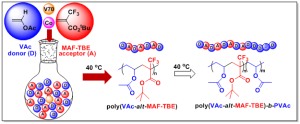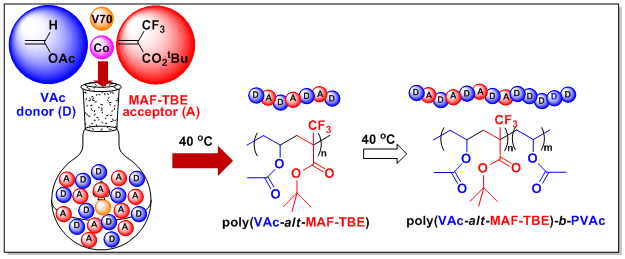In their Communication in Macromolecular Rapid Communications, Bruno Ameduri and co-workers report on the synthesis of fluorinated copolymers via organometallic mediated radical polymerization.
Fluorinated homopolymers are unique materials with outstanding properties for high value applications. The incorporation of fluoropolymer sequences into a di- or multi-block structure could lead to materials of even greater value. Reversible deactivation radical polymerization (RDRP) techniques should be ideal to achieve this goal. Alternating copolymers (containing A-B-A-B-A-B- alternating sequeces of A and B monomers) represent special types of sequence controlled polymers. However, to date, only a limited number of comonomer pairs have been reported to undergo alternating radical copolymerization such as styrene/maleic anhydride, styrene/maleimide derivatives, styrene/methacrylates, N-substituted maleimides/1-methylenebenzo-cycloalkanes, vinyl ethers/methacrylates, and chlorotrifluoroethylene/vinyl ether. For other monomer pairs, highly ordered monomer sequence control is still very challenging and considered as the “Holy Grail“ of polymer chemistry.

2-(Trifluoromethyl)acrylic acid (MAF) and alkyl 2-trifluoromethacrylate (MAF-esters) are used as comonomers to prepare interesting copolymers suitable for applications in molecularly imprinted polymers, microlithography, polymer electrolyte membranes for fuel cells and for Li-ion batteries. Organometallic mediated radical polymerization (OMRP) has emerged as one of the promising RDRP technique to prepare allow the control of radical polymerization of monomers, especially vinyl acetate (VAc). In this work, the authors aimed at developing a well-controlled radical copolymerization of VAc and t-butyl-2-trifluoromethacrylate (MAF-TBE) by OMRP. Following a straightforward “one-pot” OMRP approach, a series of well-defined fluorinated copolymers were prepared including 1:1 alternating VAc-MAF-TBE copolymers, as well as, novel block copolymer (containing a fluorinated alternating block) where this poly(VAc-alt-MAF-TBE) alternating sequence is followed by a PVAc homopolymer block. Such diblock copolymers exhibit two glass transition temperatures attributed to the alternating and homopolymer sequences. The OMRP of this fluorine-containing alternating monomer system may provide access to a wide range of new polymeric materials.

















